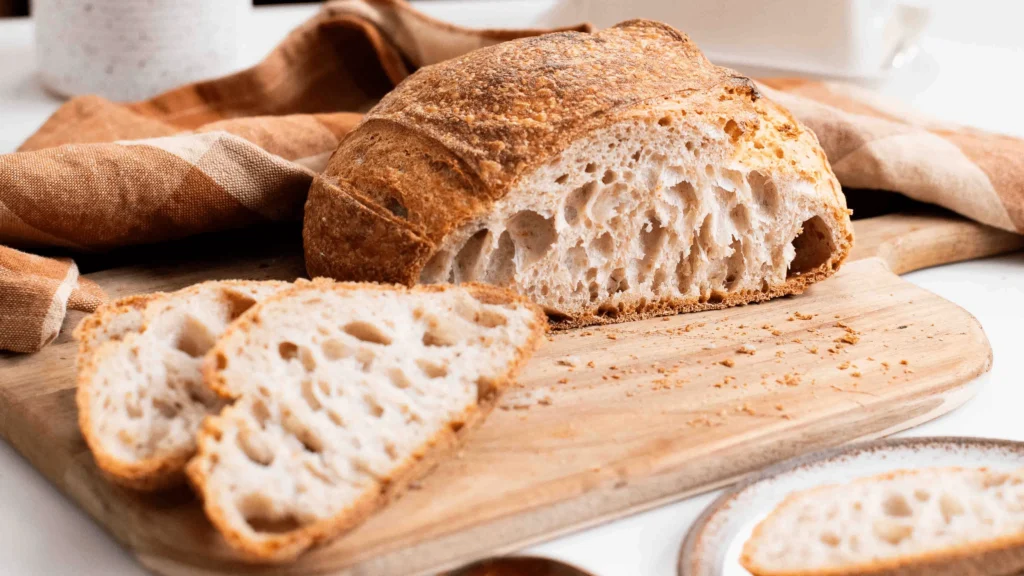If your feed is full of crackly, blistered loaves and you’re wondering, “is sourdough bread healthy?” you’re not alone. Sourdough has jumped from baker subculture to everyday staple, and for good reason. Thanks to natural fermentation, it doesn’t behave like typical bread in your body. Below, you’ll see what sets sourdough apart, what you actually get per slice, the real (science-backed) health perks, who should skip it, and how to pick or bake a better loaf.
What Makes Sourdough Different?
Natural Fermentation And Wild Yeast
Sourdough is leavened with a starter, a mix of flour and water that captures wild yeast and lactic acid bacteria (LAB). During a long, cool rise, those microbes pre-digest parts of the dough: they produce organic acids, change the dough’s pH, and start breaking down starches and some gluten structures. That’s why sourdough often tastes tangy, keeps well without preservatives, and may lead to a steadier post-meal blood sugar compared with standard white bread.
In simple terms, you’re outsourcing part of the “digestion” to microbes before you even take a bite. The acids they make can also slow the rate at which your stomach empties and the way starches are converted to sugar, one reason sourdough often shows a lower glycemic response in studies versus conventional yeast bread.

Whole Grain Versus White Sourdough
“Sourdough” describes the leavening method, not the flour. You’ll find everything from airy white country loaves to hearty 100% whole wheat. Whole grain sourdough brings more fiber, minerals (iron, zinc, magnesium), and antioxidants. White sourdough is usually lighter and easier to tolerate for some people with sensitive digestion. From a health perspective, whole grain sourdough generally wins, though fermentation offers benefits to both.
Nutrition And Macros At A Glance
Calories, Carbs, Protein, And Fiber
Per slice, the numbers vary by recipe and thickness, but here’s the ballpark for an average bakery slice (about 35–45 g):
- Calories: roughly 90–120
- Carbs: ~18–22 g
- Protein: ~3–5 g
- Fat: typically <1 g
- Fiber: ~1 g for white sourdough: ~2–4 g for whole grain varieties
So is sourdough bread healthy for weight management? It can be. Calorically it’s comparable to other breads, but the fermentation may help you feel satisfied, especially when you pair it with protein and healthy fats, think eggs, smoked salmon, hummus, or avocado.
Micronutrients And Sodium
Sourdough provides small amounts of B vitamins, iron, selenium, and manganese: whole grain versions offer more. A useful twist: fermentation can improve the bioavailability of minerals by reducing phytic acid (the compound that can bind them).
Watch the sodium. Many loaves land around 150–230 mg sodium per slice. If you’re watching blood pressure, factor that in, and remember toppings add up fast.
Science-Backed Health Benefits
Lower Glycemic Response
Several studies show sourdough bread often leads to a lower or more moderate blood sugar rise compared to bread made with commercial baker’s yeast. The mechanism isn’t magic: it’s chemistry. Lactic and acetic acids produced during fermentation can:
- Slow gastric emptying and carbohydrate absorption
- Alter starch structure, making it less rapidly digestible
- Support a steadier post-meal insulin response
You’ll still want to be mindful of portion size if you manage blood sugar. But if you’ve ever wondered, “is sourdough bread healthy for glucose control?” the evidence leans positive, especially when you opt for whole grain and eat it with protein/fat.
Improved Mineral Availability And Digestibility
Whole grains are rich in minerals, but phytic acid (phytate) can limit absorption. The friendly bacteria in sourdough activate phytases that degrade phytate, improving the availability of iron, zinc, and magnesium. That’s a quiet but meaningful benefit if bread is a regular part of your diet.
As for digestibility: fermentation starts breaking down complex carbs and some gluten bonds, and it can reduce certain FODMAPs (fermentable carbs) when fermentation is long. Many people report sourdough feels gentler on the stomach than regular bread. Important note: it’s not gluten-free, and it’s not safe for celiac disease (more on that next).
Downsides And Who Should Skip It
Celiac Disease And Wheat Allergy
If you have celiac disease, rye, wheat, and barley sourdough are off-limits, even if “long-fermented.” Fermentation does not remove gluten to a safe threshold. Similarly, anyone with a confirmed wheat allergy should avoid sourdough made from wheat flour. Look for certified gluten-free sourdough made from GF grains if you need a safe alternative.
Sensitivities, FODMAPs, And Portion Size
If you’re sensitive to fructans (a FODMAP in wheat), slow fermentation can reduce, but not eliminate, them. Some people tolerate a thin slice of long-fermented sourdough better than conventional bread: others don’t. Test conservatively and eat it with protein and fat to blunt the glucose curve.
Other watch-outs:
- Sodium can be high per slice.
- Add-ons (butter, cheese, jam) can quickly outpace the bread’s calories.
- “Sourdough” on the label doesn’t guarantee fermentation: some breads use commercial yeast plus vinegar or “sourdough flavor.” Read the ingredient list.
Sourdough Versus Other Breads
Sourdough Versus Commercial Yeast Bread
Commercial yeast breads are leavened fast, often within an hour or two. Sourdough takes 12–36 hours, giving bacteria time to build acids that shape flavor, texture, shelf life, and blood sugar impact. Practically, you get:
- Often a steadier glycemic response
- Better keeping quality (acidity slows staling and mold)
- Shorter ingredient lists (flour, water, salt, starter) versus conditioners and sugars common in packaged loaves
White Versus Whole Grain Sourdough
- Whole grain sourdough: more fiber, micronutrients, and usually better satiety: commonly a lower glycemic impact than white.
- White sourdough: lighter texture and sometimes easier on sensitive stomachs: still benefits from fermentation.
If you’re deciding purely on nutrition, whole grain sourdough wins. If you’re new to tangy breads or have a touchy gut, white sourdough can be a gentler starting point.
How To Choose Or Make A Healthier Loaf
Read Labels And Ingredient Quality
Aim for a short, clear ingredient list:
- Flour (ideally whole or a mix of whole and white)
- Water
- Salt
- Sourdough starter (may be listed as culture)
Red flags: added sugars high on the list, seed oils used as fillers, dough conditioners, or “sourdough flavor.” If yeast appears, it doesn’t automatically mean “not sourdough,” but it can signal shortcuts. Look for “naturally leavened,” “long-fermented,” or a bakery note about hours of fermentation.
Signs Of Longer Fermentation
- Packaging or bakery cards that state a fermentation window (e.g., 12–24 hours)
- Tangy aroma and a moist crumb that stays fresh a day or two without preservatives
- An irregular, open crumb and deep caramelized crust, visual hints, not guarantees
Long fermentation is what nudges health benefits like lower glycemic response and better mineral availability. If in doubt, ask the baker how they leaven the dough.
Home Baking Tweaks For Better Nutrition
If you bake at home, you control the variables:
- Use at least 50% whole grain flour (whole wheat, spelt, or rye) for fiber and minerals.
- Extend cold fermentation: 12–48 hours in the fridge can enhance flavor and reduce FODMAPs and phytate.
- Hydration matters: slightly higher hydration can improve crumb and starch retrogradation, which supports a gentler glucose curve.
- Add-ins for nutrition: seeds (flax, chia, sesame, sunflower) boost fiber, omega-3s, and minerals.
- Mind the salt: ~2% salt (baker’s percentage) is standard: reduce slightly if you need to watch sodium.
- Portion and pairing: enjoy 1–2 slices with protein (eggs, turkey, legumes) and healthy fats (avocado, olive oil) to keep you fuller and steady your post-meal blood sugar.
A small practical tip: slice and freeze your loaf. Toasting from frozen keeps waste low and portions consistent.
Conclusion
So, is sourdough bread healthy? For most people, yes, especially when it’s genuinely long-fermented and made with whole grains. You get satisfying carbs with a steadier glycemic response, better mineral availability, and an ingredient list you can pronounce. It’s not a pass for celiac disease, and it still counts toward your daily sodium and calories. But if you choose well, and pair it smartly, sourdough can be a delicious, nourishing staple that earns its place at your table.
Frequently Asked Questions
Is sourdough bread healthy?
Yes—sourdough bread is healthy for many people. Natural fermentation creates organic acids that can blunt post-meal blood sugar, and it reduces phytic acid, improving mineral availability. Whole-grain loaves add fiber and micronutrients. Still, watch sodium and portions, and note it isn’t safe for celiac disease or wheat allergy.
Is white sourdough bread healthy, or is whole grain better?
Both benefit from fermentation, but whole-grain sourdough is generally healthier. It provides more fiber, iron, zinc, magnesium, and antioxidants, and often yields better satiety and a gentler glycemic impact. White sourdough can be easier on sensitive stomachs, yet whole grain usually wins for overall nutrition.
Is sourdough bread healthy for people with diabetes?
Often, yes. Sourdough bread can be a healthy choice for many people with diabetes because lactic and acetic acids blunt post-meal glucose compared with standard yeast bread. Choose long-fermented, whole-grain loaves, keep portions modest, and pair with protein and healthy fats. Monitor readings, since responses vary.
Is sourdough bread gluten-free or safe for celiac disease?
No. Fermentation doesn’t degrade gluten to a safe threshold, so wheat, rye, or barley sourdough remains unsafe for celiac disease. People with a wheat allergy should also avoid it. If you need a safe option, choose certified gluten-free sourdough made from gluten-free grains like rice, sorghum, or buckwheat.
Does sourdough bread contain probiotics or help gut health?
Baked loaves don’t contain live probiotics—the heat kills the microbes. Still, sourdough’s fermentation can reduce certain FODMAPs and phytate, and may increase prebiotic potential and digestibility for some people. Individual tolerance varies, so start with small portions and note how your gut responds to different loaves.
What is the glycemic index of sourdough bread?
There isn’t one number. GI varies by flour type, fermentation time, hydration, and slice thickness. Many sourdoughs test in the moderate range and often lower than standard white yeast bread. Pairing with protein or fat, and choosing whole grain, can further reduce overall glycemic impact.

